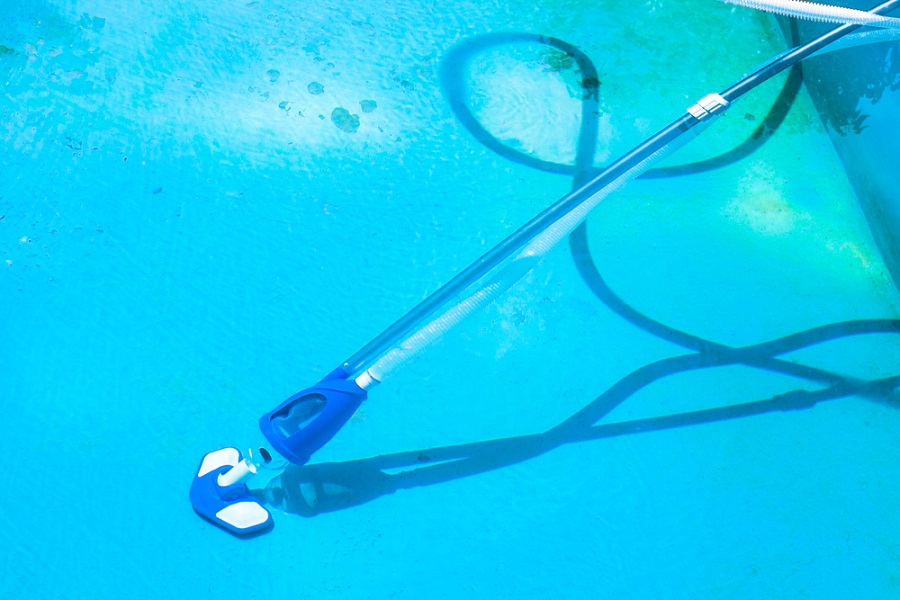Pool floors are often neglected until they become dirty and slippery.
However, thoroughly cleaning your pool floor once a year and keeping it clean all season long helps prevent damage to your pool decking and walls.
Cleaning your pool floor is an essential part of maintaining your pool. If you don’t clean your pool floor regularly, it you will find it gathers stubborn stains over time that can be very tough to remove.
In addition, leaving stains too long can sometimes damage the surface of your pool, making it easier for organisms to flourish later on.
What's In This Guide
In this short guide, we cover the basics of keeping your pool floor clean & how to remove stubborn stains when it gets dirty.
We start by discussing the most common causes of pool floor stains, then address the annual, weekly and daily things you need to do to keep your pool floor looking new and your pool water clear, healthy and bright.
So let’s dive in!
What Causes Stains On My Pool Floor?
Stains on pool floors are caused by many different things. The most common causes include:
1. Metals & minerals leaching out of your pool water into the surface. Hard water can cause calcium buildup on a gunite pool surface, for example.
2. Rust from attached ladders and other accessories in or near the pool.
3. Organic chemicals & biological materials found in nature, such as acidic leaves, bugs, algae and bacteria, are chief culprits.
Each cause requires a different type of cleaning solution. But the cleaning method is roughly the same.
How to Clean A Pool Floor Correctly: Annual Deep-Clean
Once a year, follow the steps below to thoroughly clean the bottom of your pool. We recommend doing this at the beginning of each swimming season.
Note: the procedure below applies to all above-ground and small kiddie pools, which can be safely drained 100% to clean.
WARNING: If you own an inground gunite or fiberglass pool, it must be emptied with care. Make sure you check with your pool installer for proper instructions before emptying it completely to deep-clean the bottom. Some larger/deeper inground pools are not designed to be emptied completely without compromising the structural integrity of your pool.
1. Drain Your Pool As Much As Possible
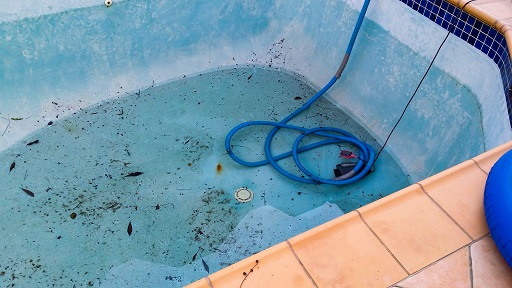
Attach a drain tube to your pool water pump’s drain nozzle to empty your pool into your local sewer system. Never empty a chlorine pool into your yard, it will kill your grass and plants.
2. Use a Garden Hose With a High-Pressure Nozzle Attachment
To clean your pool floor, you’ll need a garden hose with a high-pressure nozzle attachment attached. Choose a nozzle that provides a single high-pressure stream as opposed to a dispersed stream.
WARNING: Never use a pressure washer to clean the surface of a pool floor. Many pools use softer materials than you think, and a pressure washer can permanently damage them.
3. Rinse The Pool Floor Thorougly
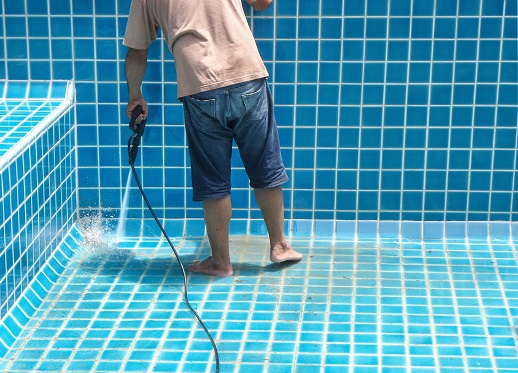
Using the nozzle attachment set on a single concentrated stream, spray down the entire surface of your pool floor. Make sure to cover all areas of your pool floor.
Use the pressure to loosen as much debris as you can.
4. Spray Down All Other Surfaces
After spraying down the entire surface of the pool floor, you’ll want to spray down the walls and other surfaces around your pool.
5. Scrub Away Remaining Dirt & Stuck-On Debris
Once you’ve sprayed down the entire surface of both your pool floor and surrounding area, you’ll want to scrub any obvious dirt and debris left behind. Use any nylon-bristled scrub brush with normal soap and water to do that.
We recommend using a pool brush to cover more area per hour. Wash down the walls after scrubbing.
There will likely still be some stains remaining. That’s OK, we’ll take care of them in a second.
6. Vacuum Up The Debris
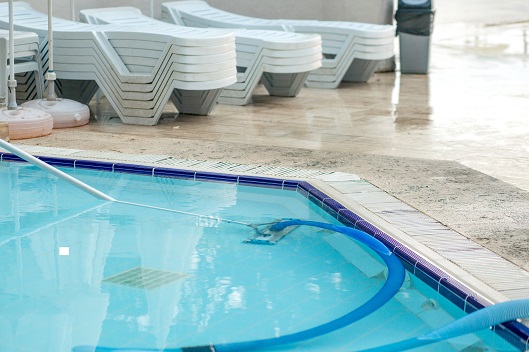
There are two ways to remove the dirt and debris you removed.
The first method is to use a wet-vac vacuum system. You can rent one from any local hardware store for $20-$40 a day. If you get daily rain in your region, then this is the best method to use.
The second / cheaper method is to let the dirty water dry out before removing the debris. Once you’re done sweeping up any loose dirt, you’ll want to use a regular dry vacuum to remove the final amount of dust.
7. Apply Chemical Stain Remover / Cleaning Solution
After vacuuming up leftover dust and dirt, you’ll want to apply a stain remover / chemical solution to your pool floor to address any stubborn stains.
To apply a chemical solution, follow these steps:
7.1. Turn On Your Garden Hose
First, turn on your garden hose by turning the handle at the end of the hose. Then, attach the nozzle attachment to the end of the hose so that it directs water toward the pool floor.
7.2. Fill a Bucket Full of Water
Next, fill a bucket full of water. Fill the bucket about halfway full.
7.3. Add the Proper Amount of Chemicals
Now, add the proper amount of chemicals to the bucket of water. Add enough chemicals to completely cover the bottom of your pool floor.
You will need to estimate the surface area of your pool to calculate how much solution you need.
7.4. Thoroughly Mix
Now, mix the chemicals together. Stir them thoroughly so that no clumps remain. When mixing the chemicals together, be careful not to overmix them. Overmixing could cause the chemicals to spill onto your pool deck or furniture.
7.5. Evenly Spread the Chemical Solution
Finally, apply the chemicals to your pool floor using a mop. Scrub lightly with a nylon brush to ensure even distribution.
7.6. Repeat Steps 7.1 Through 7.5 Until Finished
Repeat steps 1 through 5 until you are finished applying the stain remover to your entire pool floor.
As long as you don’t leave the chemicals sitting for too long, you shouldn’t have any problems finishing the job.
If you notice that the chemicals aren’t working properly, try adding more chemicals or changing the type of chemicals you use.
7.7. Thoroughly Rinse & Drain
Following the pool chemical instructions carefully, thoroughly rinse and drain the pool to remove the solution. In some cases, the chemicals can be left in the pool before refilling.
8. Refill Your Pool
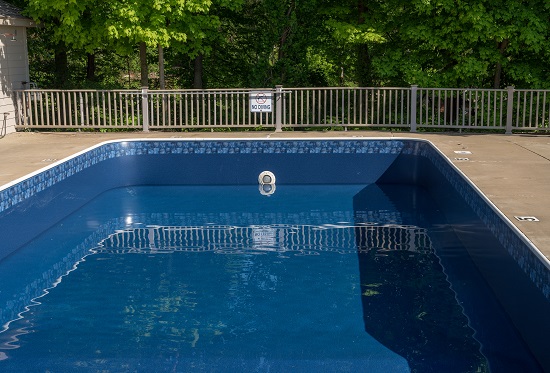
Place your garden hose on high into the pool and refill to the skimmer entry level.
9. Add Chlorine / Salt to Sanitize The Pool
After refilling, add enough pool shock, chlorine or salt to the pool to sanitize the pool water. Do not wait more than 24 hours to do this, or biologicals will start growing.
Weekly: Sweep & Remove Larger Debris
To ensure that your pool stays clear of debris, make sure that there aren’t any large objects in the bottom of your pool that could obstruct the flow of water or cannot be removed by your automatic pool cleaner.
Remove any items that might be floating around in your pool. This includes toys, plants, and leaves.
Daily Cleaning: Use An Automatic Pool Cleaner
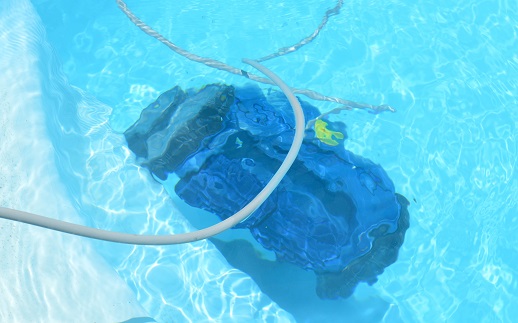
Automatic pool cleaners are great tools for keeping your pool floor clean on a daily basis.
They’re easy to set up and operate, and they move around your pool automatically so you won’t have to do anything but turn them on and empty the filters from time to time.
The best automatic pool cleaners like robotic pool cleaners include a dedicated filter that removes dirt and debris from the water. The filters in these cleaners need to be emptied once a week or so and last for a year on average.
Additional Tips for Keeping Your Pool Floor Clean
- Make sure that your pool is properly cleaned right before a long trip away.
- Be careful not to spill any chemicals near your pool.
- Avoid storing or consuming food and drinks near your pool.
- Don't let children play in your pool without adult supervision.
- Never allow pets to swim in your pool.
If you follow these tips, you’ll find that it’s easy to keep your pool floor looking its best.
FAQs
Q: What kind of chemicals should I use to keep my pool floor clean?
A: The most common type of chlorine used in swimming pools is free chlorine. However, if you don’t want to use chlorine, you can also use bromine.
If add chlorine to the pool, you should ensure that the type of chlorine product won’t harm the pool’s vinyl liner.
Q: How often should I clean my pool floor?
A: The frequency of cleaning depends on how often you use your pool and local specifics like whether your pool is under trees, near vegetation, local bug life, high or low humidity, etc.
But generally speaking, you should clean your pool’s bottom surface about once every week during season.
If you live in a humid environment and your pool is surrounded by lush vegetation, then you may need to clean the pool more frequently.
Q: Is it safe to swim in my pool after I’ve just cleaned it?
A: Yes! Many people prefer to swim in their pool after they’ve just cleaned it because it feels like they’ve never swum in the pool before.
But before diving back in, always test the pH level & chlorine level first to ensure you won’t damage the pool – or your eyes.
Q: Can I use a pressure washer to clean my pool?
A: In general, no. While a pressure washer does an excellent job removing stains from rough hard outdoor surfaces, it isn’t designed to clean swimming pools which often have softer surfaces that can be damaged by high-pressure streams.
You definitely shouldn’t use a pressure washer unless you know what you’re doing.
And even if you know what you’re doing, you should only use a pressure washer on areas where you don’t mind risking surface damage – like limiting use to the above-ground pool deck, which can be repaired much more easily.
If you have a tile pool, you should avoid using a pressure washer on the tiles. Instead, you should use a soft brush.
If you have a fiberglass pool, you should avoid putting abrasive material near the seams. Instead, you should use a soft brush to remove any dirt from the edges.
Q: What about those little black spots on my pool?
A: Those black spots are typically caused by a form of black algae. And while they look bad, they aren’t dangerous. Algae is harmless to humans. As such, you shouldn’t worry about them harming you.
Instead, you should focus on getting rid of them. To remove black algae, we recommend using a wire metal or nylon brush and a special black algaecide designed to help kill, then remove, the organism.
Make sure you follow instructions to the letter, however. Some elbow grease will be required – black algae is a stubborn thing.

